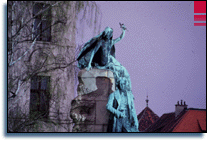Prešeren Square
Congress Square
Town Hall
Town Square and Old
Square
Cobbler's Bridge
The Market
Dragon Bridge
Plečnik's Ljubljana
Ljubljana Castle
Ljubljana in the fine arts
Musical tradition and the contemporary music scene
Theatre
The University of Ljubljana
More about Ljubljana: http://www.ljubljana.si
 |
||
| The
monument to France Prešeren in Ljubljana |
||
This square is named after the greatest Slovene poet, France Prešeren (1800-1849). The monument was unveiled in the autumn of 1905 and is a work of architect Maks Fabiani and sculptor Ivan Zajc.
For the locals Prešeren Square is the heart of the city, a meeting place where they celebrate cultural events and public holidays.
The square based on the Italian
model, is dominated by the ornamented facade of the Franciscan Church,
built between 1646 and 1660.
The Art Nouveau facades of "Ura" and "Centromerkur"
are also characteristic of Prešeren Square.
Triple Bridge (Tromostovje), a special feature of Ljubljana architecture, is made up of the old stone bridge from 1824 and two side ones which architect Jože Plečnik added in 1931, providing an entrance into the Old Town.
Basically created in the Baroque style, it was laid out in its entirety for the Congress of the Holy Alliance in 1821. The south end of the square is dominated by the building of the University of Ljubljana. The building itself was erected as a ducal palace between 1898 and 1902. Next to the University stands the Slovene Philharmonic building erected in 1891 on the foundation of the former Provincial Theatre, which had been destroyed by fire.
Adjacent is a Biedermeier house, now the seat of the oldest Slovene publishing house, Slovenska matica, founded in 1894. The northern side of the square is dominated by the Kazina, a beautiful example of Classical architecture. In the park, called Zvezda (Star), among the remains of the walls of antique Emona, stands a copy of a gold plated bronze statue of the Patrician of Emona, which was actually found here and at first mistaken for a statue of the Emperor Constantine.
The first building erected here in 1484 was rebuilt in 1718 to the plans of the architect Gregor Maeek. It has preserved a number of memorials of Ljubljana's past, including the Hercules and Narcisus fountain (the work of F.Robba's workshop) and the Gothic auditorium in which "Ljubljanchans" attended theatrical performances by itinerant comedians in the 16th and 17th centuries. Today it is the seat of the Ljubljana City Council. In front of the building stands one of the most representative monuments of Ljubljana, the Robba fountain with allegorical sculptures of the three Carniolan rivers: the Sava, Krka and Ljubljanica. It was created in 1751 by Francesco Robba, the great master of a Ljubljana sculptural studio in the first half of the 18th century.
The two squares flow one into another and then into Gornji trg (Upper Square). All there, which combine to form the Old Town, are of a typically Gothic, wreathed design. The houses are almost all Baroque; only some with their axes at right angles to the street have retained their medieval layout.
The Old Town hums with restaurants, art cafes, galleries and antique shops
Čevljarski most (1931-1932) stands on the site of a former bridge on which first butchers and later cobblers had their premises. The architect Plečnik made a wide bridge, a real square, supporting it on a concrete pier laid lengthways along the river Ljubljanica. He ornamented the surface of the bridge with moulded consoles, set 6 pairs of columns with orbs on the capitals of the balustrades and supplemented the individual dynamic lines of the columns with lower pairs of columns with triple lights. The bridge is white, in dynamic play with the free standing forms against the green trees along the slightly curving current of the Ljubljanica.
Along the Ljubljanica, from the Vodnik Square to the Triple Bridge, stands Plečnik's famous Market, a long monumental building with colonnades. On the waterside, the market buildings are faced with rustic stonework below a smooth storey of lunettes, and they open to the road with inset doors between massive boundary stones. To this he later added a flower-shop and an open porch, an effective introduction to the monumental, clearly segmented, composition of the markets, whose colonnades vie with those in front of the Church of St. Peter in Rome. Opposite the monumental flower-shop on the other side of Tromostovje, as a twin, is a tobacco shop, a small architectural feature with two pillars supporting a projecting roof. Plečnik believed that even such prosaic tasks deserved serious, even monumental, study.
The Ljubljana market is one of the most attractive in Central Europe. There you can find almost everything.
Zmajski most stands by the market place and was built in 1901 on the site of the former wooden "Butcher's Bridge". It was named after the Emperor Franz Joseph, although only on paper since the name was never adopted in practice. The bridge is a concrete and iron structure and was among the first of this type in Europe. It was ornamented by Otto Wagner's pupil, Jurij Zaninovich.